Joe Muskin & Team: Nano-CEMMS' Ambassadors for STEM Education

Left to right: Matt Alonso, Athena Lin, and Joe Muskin
July 9, 2012
"Everywhere you go, the ubiquitous Joe." —Betsy Innes
If you make the rounds of campus outreach very often, you will soon discover that one of the constants in the STEM-education-outreach universe is Joe Muskin…and company. Part of the education arm of Nano-CEMMS (the Center for Nanoscale Chemical-Electrical-Mechanical Manufacturing Systems), Joe and his crack team, NanoCEMMS education coordinator Matt Alonso; education coordinator Carrie Kouadio, Joe's girl Friday and rising high school junior, Athena Lin; plus a number of local science teachers are involved in numerous events, ranging from school visits to campus, to on-site visits to schools, to on-campus professional development for science teachers from around the state, to summer camps, and the list goes on.
Day in and day out, like a well-oiled machine, he and his staff routinely expose the public to some of the university's exciting, cutting edge research. Joe recites a litany of upcoming outreach events for the rest of the week: Wednesday, 3-D printing at MNTL with some high school kids; Thursday, he and his staff are taking some people from CERL into the Clean Room; Friday, summer camp youngsters from the Discovery Museum in Bloomington-Normal are visiting campus. Just another day at the Nano-CEMMs outreach office. However, when Nano-CEMMS first began conducting outreach activities, they were more of a novelty.
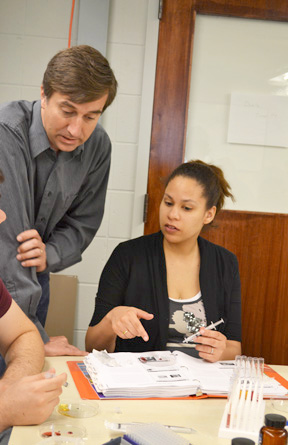
Joe Muskin works with a teacher during an EnLiST workshop on gold and silver nanoparticles.
"It's kind of funny," Joe reminisces. "That very first year, we were really excited because we were invited to one school to give a career day talk. We went to another school for kind of a science thing. We thought, 'Wow! Look at this; we're actually doing it!' And now we're doing that kind of stuff weekly…The way it kind of ballooned is really exciting…It just kind of snowballed. I love seeing this program grow over the years."
Joe describes what he likes best about his job: "What I really like about Nano-CEMMS is that I can design the whole program…There's so much to do: developing new material, bringing material out to the schools, bringing students here, bringing them to the Clean Room, exposing them to science, getting them excited about science and engineering. I can do so much with that through Nano-CEMMS."
Joe credits Placid Ferrera, the first director of Nano-CEMMs, with the emphasis on and success of its education program. According to Joe, in many grant projects, education is just an after-thought; however, this is not the case in NanoCEMMS: "Placid was the one who made it a big deal." With the director's encouragement to emphasize education, Joe and others were able to go into the labs of the Nano-CEMMS professors, who helped develop the materials that would be taught in classrooms and made their grad students available to them.
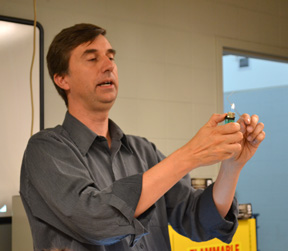
Joe Muskin demonstrates a principle during a teaching session.
"It was a good marriage, where we had the expertise of the graduate students and the professors, and then we had some good teachers who knew what was going on in the classroom, and bringing that together in a meaningful way instead of just bringing teachers in and giving them a little thing. But actually, there was a real dialogue going on, and that dialogue is what really started it. So then we developed a lot of quality educational activities."
Although Nano-CEMMS is in the department of Mechanical Science and Engineering, Joe and his staff can often be found doing outreach for units and programs outside their home department…and the University. "Placid really instilled that in us, and the great thing is, John Rogers keeps that going. John believes it too, that education is very important...So always, at the top, we've always had this, 'Education is important. Do what we need to do to get it done.' So we haven't been departmentalized; we don't just stay in our own little niche. When people want something, we're happy to accommodate. We're happy to go out and do what needs to be done to bring this message that science and engineering are cool, and a great job, out to the general public…Both Placid and John have been really good at letting us run with the ball. They've always been very supportive. They've never said, 'No, don't do this; don't do that. They've always said, 'Yes. Go. Sounds great!'"
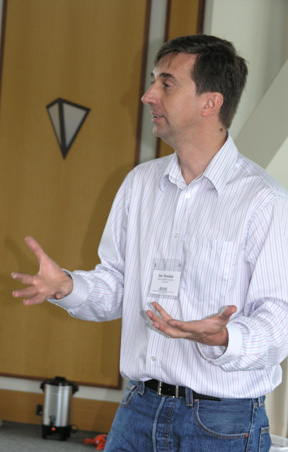
Joe Muskin sharing his passion for science with Edison Middle High School students during an iRise outreach event.
So how did Joe learn about nanotechnology? "Just picking it up as I go along. I love learning myself. I've always loved classes…I really like learning new things." Joe doesn't just like learning; he enjoys teaching all the new things he's learned, and got into the profession through a rather circuitous route. Joe got his undergraduate degree in biology and did research in a biology lab. But he found it to be tedious.
"I would be doing a technique, and it wasn't a lot of the thinking kind; it was just the doing kind. So I kind of got bored with it. I don't like the cook-book aspect of it, where you're doing the same technique again and again and again for weeks and weeks and weeks. I like getting results; I like analyzing the results and then moving on. But I didn't like the drudgery."
So Joe tried computers, and while he was getting his Masters in computer science, he also picked up a teaching certificate. He had discovered that he liked teaching as a graduate student in biology. "I quickly discovered that I was actually pretty good at teaching, and I really liked it…I really enjoyed the interactions with students."
Laid off of his job with a software company when it outsourced his entire department, he said to himself, "Well, I always thought about retiring into teaching; I'll just retire a little bit early." So he got a teaching job at Blue Ridge School in Mansfield/Farmer City, Illinois, then spent several years teaching part-time at Next Generation School in Champaign and working for Nano-CEMMS part time. He eventually ending up taking on Nano-CEMMS's education outreach full time. Joe has been with Nano-CEMMS for eight or nine years.
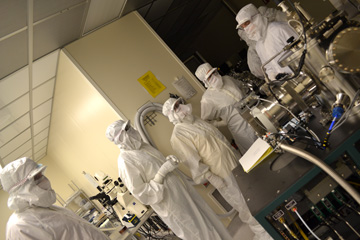
Matt Alonso (far right) discusses some of the Clean Room equipment during an EnLiST workshop.
Summers are busy for Joe and his team. For instance, for the last several years, they have done a two-week professional development workshop for EnLiST (Entrepreneurial Leadership in STEM Teaching & Learning). To help with summer workshops like EnLiST, Joe has assembled a team of local science teachers: John Scott from Bloomington-Normal, Janet Watman from Mahomet, and David Bergandine from University Laboratory High School in Urbana. Janet and David were in the first teacher workshop he did eight years ago; John was in the workshop the second year. Joe calls them "standout teachers who worked really hard," thus, he has had them come back to help with the teacher professional development ever since.
Given the different audiences Joe and his crew work with, ranging from kids to teachers, young to old, and with widely varying prior knowledge, the highly technical information they dish out must be age and background appropriate. Joe particularly enjoys this aspect of distilling the information down to a level a given group can understand.
"I love doing that. I think I'm good at that. I think I have a sense of what's happening inside somebody's head. I'm able to construct my explanations based on their prior knowledge, where they're coming from. I don't assume too much knowledge, but if they seem to understand, then I'll speed things up a little bit…I think I'm kind of good at gauging where they're at. You can kind of see that glassy-eyed look when they don't quite get what you're saying, so you can modify what you're saying."
If this paragon of STEM education has a weakness, it's organization. But he credits his computer and his team with getting him to the events prepared. Matt agrees.
"Every day, it's 'What's going on today?' So we all come together to figure it out…It it's not in his RAM…"
Athena Lin
Luckily for Joe, Athena is already ironing out the kinks of one of the activities they will do at the G.A.M.E.S. (Girls' Adventures in Mathematics, Engineering, and Science) camp coming up in July.
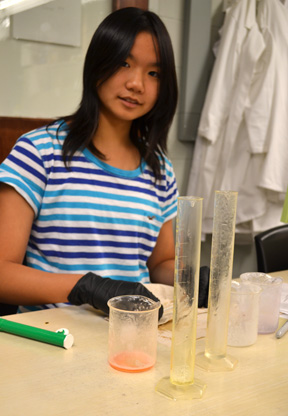
Athena Lin prepares an activity for the G.A.M.E.S. camp.
"Yes," Joe adds, "and she doesn't realize it yet, but we've also got another project for her to start working on!" He then goes on to describe a new technique for analyzing bone material from Amy Wagoner Johnson's research that they will be evaluating to see if they might be able to incorporate it into their repertoire.
Besides helping to prepare lesson activities, another of Athena's responsibilities is training teachers on the SEM (Scanning Electron Microscope). Despite her youth (she is a high school student who is serving as an intern at Nano-CEMMS this summer), she is an expert, and Joe has made her responsible for the SEM training they provide.
How did Athena get involved with Nano-CEMMS? Joe was her science teacher in the 5th through the 8th grades at Next Generation Middle School. Athena indicates that Joe was one of her favorite teachers in junior high. He was the one who really encouraged her to pursue science; plus she really appreciated the hands-on aspects of science as a youngster. And like the Pied Piper of Science, Joe led her here to Nano-CEMMS and the University.
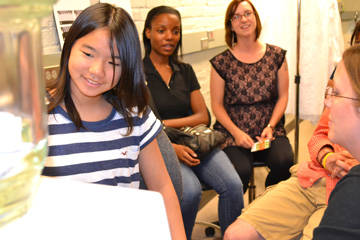
Athena Lin initiates EnLiST teachers into the mysteries of the SEM microscope.
On target to graduate a year early, she definitely intends to apply here at Illinois. What has influenced her decision to study engineering? She credits the people she's worked with, the dearth of females in engineering, plus the fact that engineering is a respected field which is applicable to several areas of study. Has working with Nano-CEMMS this summer confirmed her decision regarding a career in engineering? Athena says it has.
"Working with the equipment has given me perspective about what I really would be doing later on. So far, it's all been an enjoyable experience...I really appreciate all the opportunities Joe has given me that have cemented my interest in engineering and helped me develop research skills that will be instrumental in my future education."
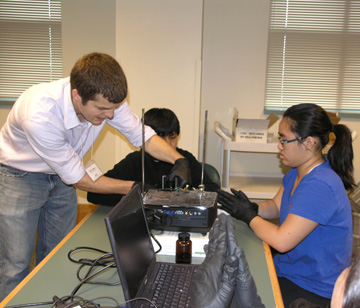
Matt Alonso works with Edison Middle School student during iRise event.
Matt Alonso
Like Athena, Matt Alonso has also found working with Nano-CEMMS to be enjoyable. He indicates that one of the most rewarding aspects of the program is watching students succeed.
"Seeing the students progress and make positive decisions based on the knowledge you've imparted to them really fills me with joy. Through the outreach activities, we don't always get to see the outcomes, but with the NanoCEMMS NanoChallenge High School Research Program, we do."
Like Joe, Matt has learned a lot through the program: "I also enjoy the learning aspect. Due to the nature of the work in NanoCEMMS, I've been exposed to several areas of science I didn't have much knowledge in, and now I've had the opportunity to learn about it and pass that knowledge on."
Because of its mandate to educate the public, NanoCEMMS has had a far-reaching impact, both geographically and in its impact on participants' career choices. According to Alonso, its impact has spread to his home town.
"I think the sheer number of requests we get to do outreach activities really speaks to the success of NanoCEMMS. Every now and again one of us will meet a student and they will tell us about an activity they did years ago with NanoCEMMS, its really amazing to hear that. When I was in high school, NanoCEMMS didn't exist yet, but another activity called FIRST robotics brought me into Engineering, so I know these activities work. Just last week, I am excited to say, NanoCEMMS finally reached my home community in Freeport, IL. I taught a 3D printing lesson to a group of students, and one of them came up to me afterwards to ask a few questions about doing the activity, and he was from Freeport! Can't wait for the school year to begin and for us to have a request to teach students in Freeport about Nanotechnology!"
Author/Photographer: Elizabeth Innes, Communications Specialist, I-STEM Education Initiative
More: EnLiST, Nano-CEMMS, Teacher Professional Development
, 2012













.jpg)
















